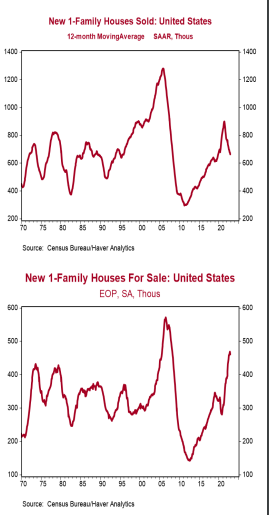- New single-family home sales increased 5.8% in November to a 0.640 million annual rate, beating the consensus expected 0.600 million. Sales are down 15.3% from a year ago.
- Sales in November rose in the West and Midwest, but fell in the Northeast and South.
- The months’ supply of new homes (how long it would take to sell all the homes in inventory) fell to 8.6 in November from 9.3 in October. The decline was due to both a faster pace of sales and an 8,000 unit drop in inventories.
- The median price of new homes sold was $471,200 in November, up 9.5% from a year ago. The average price of new homes sold was $543,600, up 9.0% versus last year.
Implications:
New home sales surprised to the upside in November, rising for the second month in a row and signaling that activity may finally be stabilizing after falling for most of 2022. The main issue this year has been declining affordability, with potential buyers getting squeezed by both higher prices and rapidly rising mortgage rates. Assuming a 20% down payment, the change in mortgage rates and home prices since December 2021 amount to a 69% increase in monthly payments on a new 30-year mortgage for the median new home. No wonder sales have slowed down! With 30-year mortgage rates currently sitting near 6.5%, financing costs remain a headwind. However, it’s important to note that mortgage rates have recently fallen roughly 80 basis points from the peak, with most of the decline occurring during November. Given that new home sales are a timelier indicator of the housing market, because they are calculated when contracts are signed, it’s not surprising we are seeing signs of life in today’s report while sales of existing homes (which are counted when contracts are closed) continue to struggle. Another piece of good news is that while a lack of inventory has contributed to price gains in the past couple of years, and inventories did slip in November itself, inventories have made substantial gains versus a couple of year ago. The months’ supply of new homes (how long it would take to sell the current inventory at today’s sales pace) is now 8.6, up significantly from 3.3 early on in the pandemic. While the months’ supply of completed homes is still a relatively low 1.2, the inventory of completed single-family homes has begun to rise quite rapidly as builders finish more units and rising cancellation rates on purchases leave potential buyers with more options. Though not a recipe for a significant rebound, the combination of moderating mortgage rates and more inventories should continue to put a floor under sales activity. One problem with assessing housing activity is that the Federal Reserve held interest rates artificially low for more than a decade. With rates now in a more normal range, the sticker shock on mortgage rates for potential buyers is very real. However, we have had strong housing markets with rates at current levels in the past, and homebuyers will eventually adjust.





